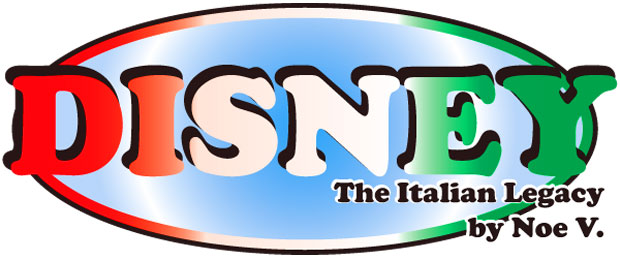
Each figure released with the De Agostini Disney Collection came with a dozen-page magazine. This magazine highlighted the character and gave all sorts of information about them including first appearance and notable stories they were featured in. My favorite in the collection was surprisingly not Scrooge McDuck but instead his oldest rival in canon. The Italians called him Nonno Bassotto, to English speakers it was Grandpa Beagle, the patriarch of the notorious Beagle Boy clan.
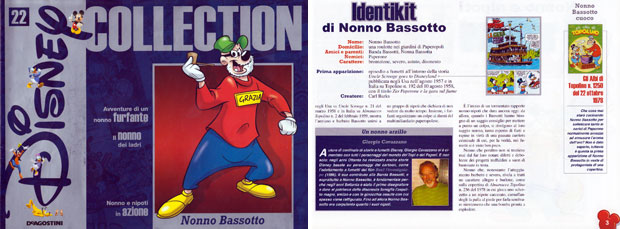
The Collection magazine featured an interview with the superb artist Giorgio Cavazzano as well as his insights to the long running character. Some of his best moments in comic history were featured as well as a comparison article to how the character was presented around the world.
The Collection made the distinction that the eldest member of the Beagle clan made his debut as Blackheart Beagle in the 1957 story The Fantastic River Race. In later appearances in US comics, most drawn by Don Rosa he would return not with a long thin mustache but with a full white beard. This character would still be known as Blackheart rather than Grandpa. Blackheart Beagle and the pipe-smoking Nonno Bassotto were one and the same person, each was just presented differently in each country.
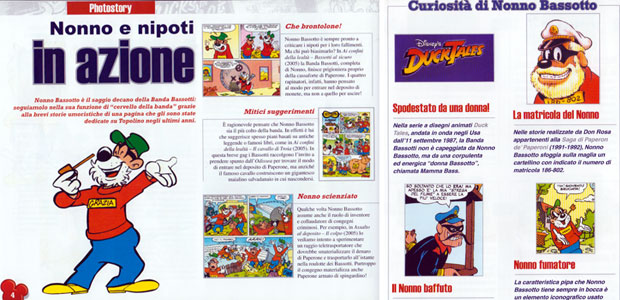
The collection magazine also noted that in the animated series Duck Tales the role of Blackheart Beagle was played instead by his wife Ma Beagle.
Blackheart Beagle was only sparsely used in the US. His offspring made far more appearances and even had their own comic series for a while in the US. By comparison Nonno Bassotto was a main player in the pages of Topolino. He would constantly play the foil against Scrooge, Donald, Mickey and even Paperinik. And just like Scrooge, he was still somewhat animated despite his age. His appearances were often marked by bits of comedic writing as he had little patience for his children.
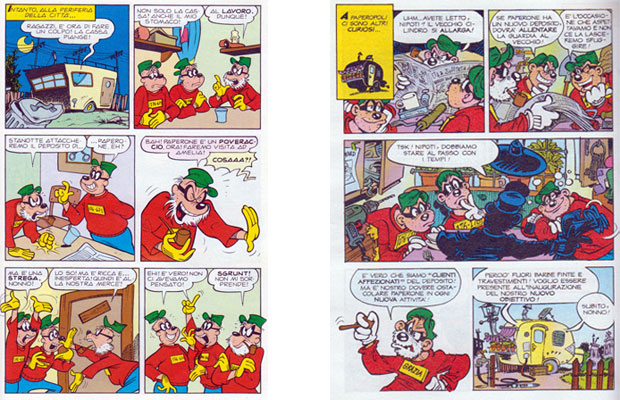
In Italy the Beagle Boys were headquartered out of a little yellow trailer on the outskirts of town. The trailer became as identifiable in the comics as the Money Bin or Donald Duck’s 313 car. As the decades progressed the shape of the trailer changed slightly but the Beagles never moved out. They would try to devise plans on getting into Scrooge’s Money Bin. All the while Nonno would train his kin on all sorts of criminal activities and expound the virtues of larceny. As with the other De Agostini figures in the Disney Parade and Disney Collection series the sculpt for Nonno Bassotto had to tell a story. The figure had to convince audiences that he was based on a living character. Behind the mask collectors had to see a villain thinking up a grand scheme. When I look at the statue I think De Agostini got him completely right. His stance leaning to one side, one hand in pocket and the other cradling his pipe, looking over his shoulder, Nonno was certainly up to something.
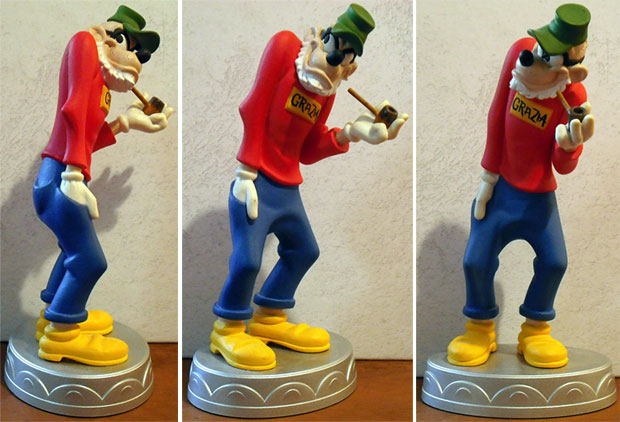
The figure reminded me of what had been lacking for collectors in the USA. As Topolino magazine constantly reminded audiences what was so great and memorable about the Disney universe, so too did De Agostini create figures and collectibles that were relevant to the universe. Compare this to how the Disney characters were marketed and distributed in the USA. While visiting the toy section of various stores and even the ones at the theme parks I kept a mental count of what Disney figures I could find that were comparable to the De Agostini ones. Many of the iconic characters appeared on children’s toys, plush figures and clothing. Older kids could find figures based on Disney / Pixar’s Toy Story and Cars. But when it came to figures based on the library of characters featured in Topolino magazine they were nearly impossible to find. I’m not talking about obscure characters either; I mean Mickey, Minnie, Donald, Goofy and Pluto. In the parks themselves there were expensive high-end statues featuring some of the characters, play sets based on theme park attractions and Vinylmation figures with images stamped onto a generic bear shape but not simple figures of the characters for sale.
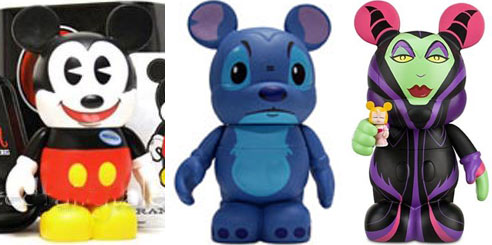
When it came to actual dedicated figures of the mascots and the extended universe there was nothing available in or outside of the parks. The next time you go to a big retail store look at the toy section and see if you can find anything remotely close to what De Agostini was producing, or for that matter, anything comparable to the Topolino gadget sets. What was Disney doing or not doing in the USA to make these characters relevant to newer generations?
Disney had not produced a 2D animated series featuring the mascots in years. The only series they seemed to have going was a 3D show for toddlers called the Mickey Mouse Clubhouse. The Disney Channel rarely showed any classic animation, and the Disney XD channel showed cartoons from Marvel and live-action shows instead of any classic material. The merchandise available in stores and parks placed iconic figures alongside characters barely a season old. Disney seemed to be doing the bare minimum to create, market and sell products in the US. The more “collectable” they could make an item appear, by simply changing a color scheme for example, the easier they could control the market. The US Disney consumer goods team seemed to be doing the bare minimum to create products. Some would argue that they were being lazy and too focused on the bottom line.
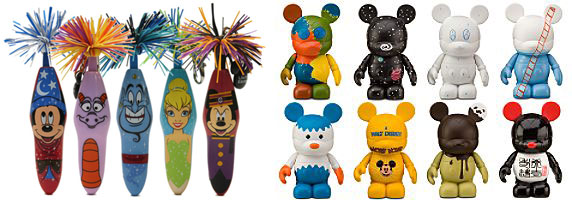
Consider the amount of work that went into creating a monthly series of comics, developing gadget toys for subscribers and sculpting a series of figures for collectors. From a business standpoint the overhead must have been tremendous but the end result was definitely worth it. Fans in Italy could still walk into a store and find clothing with the mascots on them, or into any toy store and buy items from the latest Pixar film. Disney in Italy was doing a lot to give consumers choices. They kept the mascots alive and well in print even if they could not do so on television. Part of the success of the mascots in Italy had to do with the Disney Academy.
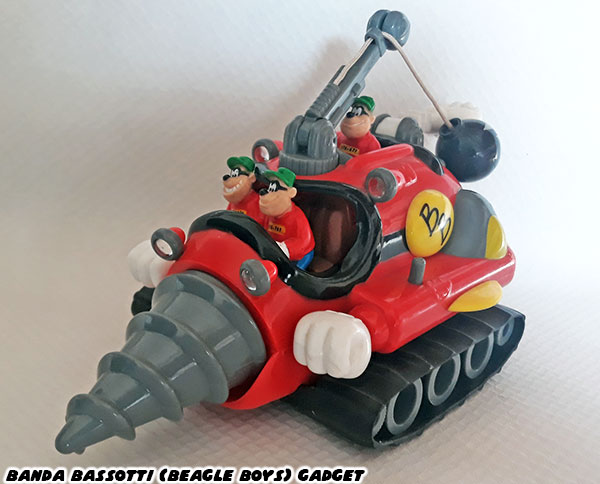
The coalition of artists in Italy, now several generations deep, had a hand in design for consumer products and advertising. When they weren’t working on comics they were helping to produce figures and toys with great attention to detail. The USA seemingly had nothing comparable. They did not have a market or use a media outlet to promote the icons in any format, especially not within the pages of a family friendly comic. Disney USA chose instead to license whatever they could not manufacture or develop themselves. The next blog will challenge the idea of licensing Disney characters rather than developing products in house. Were there any rare Disney characters that you were a fan of? I'd like to hear about it in the comments section. As always if you would like to sponsor me
please visit my Patreon page and consider donating each month, even as little as $1 would help make better blogs and even podcasts!



















No comments:
Post a Comment